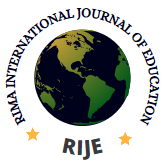ASEI-PDSI Approach Level Of Awareness Of Among Mathematics And Science Education Student In Sokoto State University
Aliyu Garba, Hassan Aliyu & Faruku Aliyu
Department of Science Education, Faculty of Education, Sokoto State University
Abstract
To assess the current level of awareness towards Activity Students Centred and Improvisation Plan Do See Improve ASEI-PDSI Approach among Mathematics and Science Education Student in Sokoto State University the Study designed level of awareness of ASEI-PDSI approach among mathematics and science education student Questionnaire (LAOAMASEQ). The main objective of this study was to expose Mathematics and Science student’s teacher to the new approach and assess the level of awareness of ASEI-PDSI Approach and gender disparity. Data were collected from a sample of 217 respondents. From the result, majority of the respondents portrayed very little knowledge about ASEI-PDSI Approach. So also, there is no significant difference between male and Female students with regards to ASEI-PDSI level of awareness among mathematics and Science education students’ teachers in Sokoto state university. The findings recommended that the module should be develop for mathematics and Science education students’ teacher in tertiary institutions, Government should encourage SMASE INSET and Government should integrate ASEI PDSI approach into teacher education programmes among many more.
Keywords
ASEI PDSI, Awareness, Gender, Mathematics Education, Science Education
Reference
Asikhia, O. . . (2014). Effect Of Cognitive Restructuring On The Reduction Of Mathematics Anxiety Among Senior Secondary School Students In Ogun State , Nigeria. International Journal of Education and Research, 2(2), 1-20.
Birgin, O., Balo, M., Hakan, H., & G Ramazan, R. (2010). An investigation of mathematics anxiety among sixth through eighth-grade students in Turkey. Learning and Individual Differences, 20(6), 654-658. https://doi.org/10.1016/j.lindif.2010.04.006
Bursal, M., & Paznokas, L. (2006). Mathematics anxiety and preservice elementary teachers’ confidence to teach mathematics and science. School Science and Mathematics, 104(6), 173-180. https://doi.org/10.1111/j.1949-8594.2006.tb18073.x
Dangpe, A. K. D. (2015). Effects Of Experiment And Improvisation Based Model On Students’ Achievement And Interest In Circle Theorems. University of Nigeria, Nsukka, Enugu State, Nigeria.
Devine, A., Fawcett, K., Szűcs, D., & Dowker, A. (2012). Gender differences in mathematics anxiety and the relation to mathematics performance while controlling for test anxiety. Behavioral and Brain Functions, 8(1), 33. https://doi.org/10.1186/1744-9081-8-33
Emeji, E. O. (2021). Effects of using asei-pdsi approach of teaching on the academic performances of students in basic science in junior secondary schools. 9(2), 1467-1474.
Finlayson, M. (2014). Addressing math anxiety in the classroom. Improving Schools, 17(1), 99-115. https://doi.org/10.1177/1365480214521457
Geist, D. E. (2015). Math anxiety and the “math gap”: How attitudes toward mathematics disadvantage students as early as preschool. Journal of Instructional Psychology, 135(3), 328-337.
Hassan, A., & Shahid, M. A. (2010). Scholars, Merchants and Civil Society: Imperative For Waqf-Based Participatory Poverty Alleviation Initiatives In Kano, Nigeria. In A. G. Ismail, M. E. M. Hassan, N. Ismail, & S. Shahimi (Eds.), Management and Development of the Awqaf Assets (pp. 309–328). https://doi.org/10.1109/INCOS.2010.100
Jordan, W. J., & Education, U. (2017). Mathematics Confidence In An Urban High School : Black Students ’ Perception Of Mathematics Education. May.
Katiambo, D. (2019). Effect of ASEI-PDSI SMASSE Approach to Teaching on Mathematics Learning Outcomes in Secondary Schools in Kenya. Kenya: Kibabii University.
Morsanyi, K., Busdraghi, C., & Primi, C. (2014). Mathematical anxiety is linked to reduced cognitive reflection: a potential road from discomfort in the mathematics classroom to susceptibility to biases. Behavioral and Brain Functions : BBF, 10(1), 31. https://doi.org/10.1186/1744-9081-10-31
Mutodi, P., & Ngirande, H. (2014). Exploring Mathematics Anxiety: Mathematics Students’ Experiences. Mediterranean Journal of Social Sciences, 5(1), 283–294. https://doi.org/10.5901/mjss.2014.v5n1p283
Obomanu, B. J., & Adaramola, M. O. (2011). Factors Related to Under Achievement in Science, Technology and Mathematics Education (STME) in Secondary Schools in Rivers State, Nigeria. World Journal of Education, 1(1), 102-109. https://doi.org/10.5430/wje.v1n1p102
Olubukola, A. (2015). An Investigation of Difficult Topics in the Senior Secondary School Mathematics Curriculum as Perceived by Student Teachers. American Journal of Educational Research, 3(7), 844-848. https://doi.org/10.12691/education-3-7-7
Rossnan, S. (2006). Overcoming Math Anxiety. Mathitudes, 1(1), 1-4. https://doi.org/10.1007/BF03024518
Siocha, N., & Nyagaka, E. (2021). International Journal of Applied Science and Research Overview Of Girls’ Performance In Biology Subject In Kenya Certificate Of Secondary Education: What Is The Way Forward? April 2000, 198–207.
Tobias, S., Serow, P., & Schmude, M. (2009). Critical Moments in Learning Mathematics : First Year Pre-service Primary Teachers ’ Perspectives. Proceedings of the 33rd Annual Conference of the Mathematics Education Research Group of Australasia. Fremantle: MERGA, 804-811.
Whyte, J., & Anthony, G. (2012). Maths Anxiety: The Fear Factor in the Mathematics Classroom. New Zealand Journal of Teachers’, 9(1), 6-15. http://www.teacherswork.ac.nz/journal/volume9_issue1/whyte.pdf
